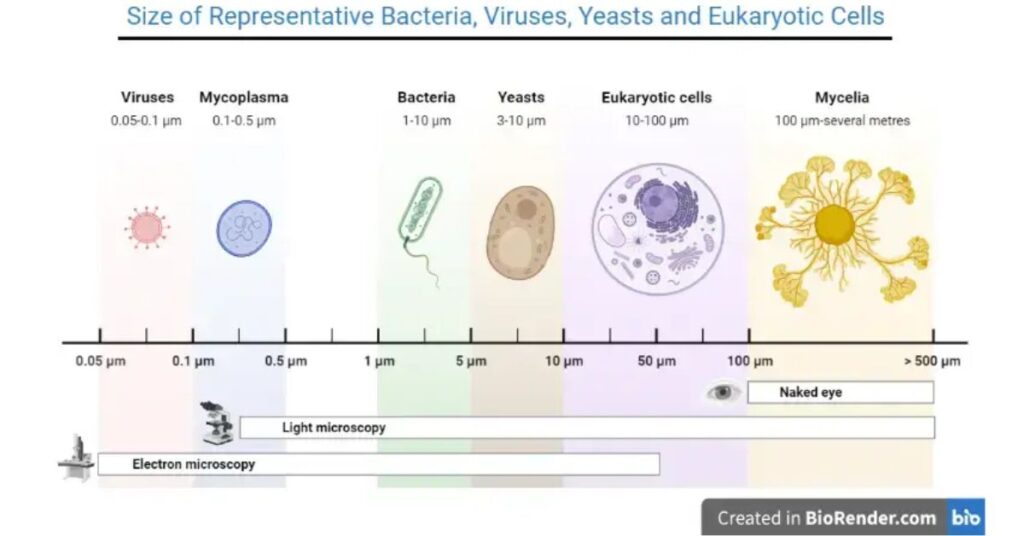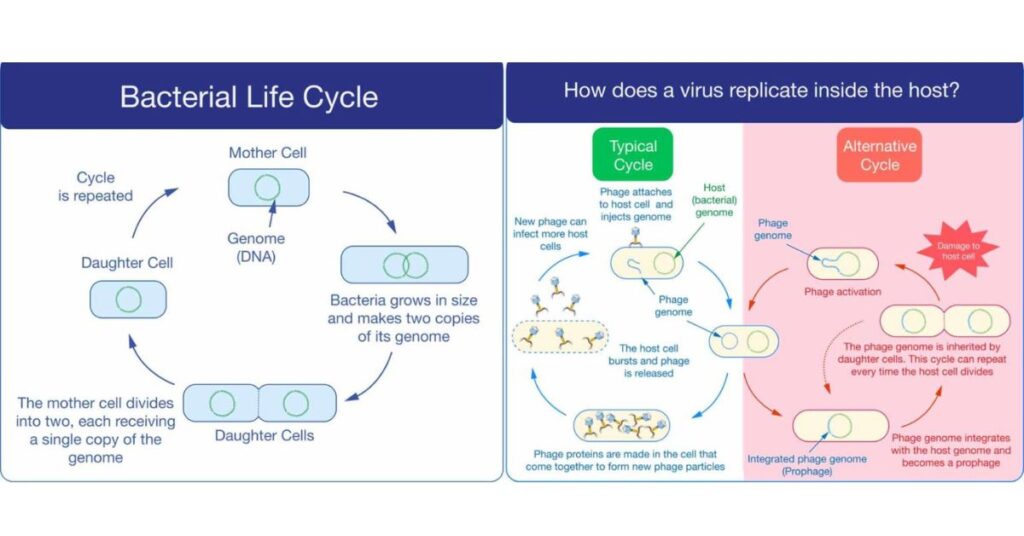Biological structure
Bacteria are single-celled organisms with a cell wall and cell organelles.
Viruses have a cell coat instead of a cell wall, as observed in pathogens like the Coronavirus helps them bind to the human receptor proteins. Unlike bacteria, they don’t have a cellular structure.

Sustenance
Most bacteria obtain energy by decomposing dead organisms and wastes or breaking down chemical compounds. They can live both inside and outside the human body. Viruses, unlike bacteria, do not have ribosomes, mitochondria, or other organelles and depend on their hosts for survival. Outside the host body, they are metabolically inert.
E.g., The E.Coli bacteria can survive in the soil for 130 days and in river water for 27 days and even live healthily in the intestines of animals and the human body. The Corona Virus, on the other hand, survives for only 1.5-3 hours in the atmosphere and needs a medium like liquid droplets transmitted through the cough or sneezes of the infected person or solid surfaces like copper, cardboard or stainless steel to survive externally for a more extended period. Inside the body, it can survive for a minimum of 10 days while in some the virus remnants can survive for months.
Size
Bacteria are larger, with the average-sized bacterium being approximately 2 microns long and 0.5 microns in dia.
A virus is much smaller, with an average dimension of 0.2-0.25 microns.

The smallest bacteria are about the same size as the most giant viruses and are the smallest organisms capable of existing outside a host. Because of their bigger size, they are visible under a light microscope, but viruses are so small that they can only be viewed through an electron microscope.
Reproduction
Bacteria reproduce through Binary Fission ( growing into twice their size and splitting into two)
Viruses replicate within the host by hijacking its cellular machinery. Studies about the severe acute respiratory syndrome coronavirus have shown the spike proteins to interact with the ACE-2 receptors of the host cells to activate their membrane fusion capacity and release genomic RNA that helps them replicate rapidly.

Nature of infection
Infection-causing bacterial pathogens are transmitted through contaminated surfaces and fluids. Viruses, on the other hand, are spread through the air and are more easily spread.
Bacteria are transmitted through
- Contaminated food and water
- Touching contaminated surfaces
- Cuts
- Close contact with infected person or their metabolic wastes like vomit or feces
- Breathing the droplets exhaled by an infected person
A virus is transmitted through
- Cough
- Sneeze
- The bite from infected animals and insects
- Exposure to infected bodily fluids through sexual intercourse or infected hypodermic needles
Sometimes viruses use bacterial cells as their host and infect bacteria as well. These viruses are referred to as bacteriophages, and they don’t infect humans or other multicellular organisms.

Treatment of bacterial and viral infection
The body reacts to bacterial infections through inflammation, immune system activation, and antibody production to attack and destroy the bacteria. In some cases, antibodies inactivate toxins produced by bacterial pathogens like S.aureus and S.Pyogenes. Serious bacterial infections are treated with antibiotics that disrupt the bacteria’s metabolic processes and destroy its cell wall.
Antibiotics don’t work against viruses. To manage viral infections, antivirals and immunization are more important. Antivirals help your immune system fight back by preventing the virus from replicating within the system. Immunization is conducted by stimulating the body’s immune system to produce antibodies for fighting the virus.
| Characteristic Feature | Bacteria | Virus |
| Structure | It contains a cell membrane and a cell wall | Lacks a cell membrane and a wall |
| Size | Bigger in size between 900-1000 nm | Smaller in size between 30-50 nm |
| Types | Bacilli, Cocci, Spirochaetes, Vibrio | Icosahedral, Helical, Enveloped, Complex |
| Reproduction | Binary Fission, both inside and outside the host | Inside the host by hijacking their cellular machinery |
| Microscopic Visibility | Light Microscope | Electron Microscope |
| Metabolism | Have metabolism of their own | Do not have a metabolism of their own |
| Cell-wall | Present | Absent |
| Non-living / Living | Classified as living | Neither living nor non-living |
| Ribosomes | Present | Absent |
| DNA/RNA | DNA and RNA drift freely in the bacterial cytoplasm | DNA and RNA are enveloped inside a protein coat |
| Mode of infection | Cuts, infected metabolic waste, contaminated food | Cough, sneeze, bite, contaminated surface |
| Disease | Pneumonia, Sepsis, TB, UTIs, Cholera | Covid-19, common cold, flu, HPV, Aids, Herpes Simplex Infection |
| Treatment | Not all bacteria are harmful. Those that are are treated with antibiotics | Antivirals, Immunization |
| Examples | Staphylococcus, E.Coli, Lactobacillus, Salmonella, Listeria | Sars-Covid Virus, Adenovirus, HPV virus |
Reference:
- www.genome.gov/genetics-glossary/Bacteria#:~:text=Bacteria%20are%20small%20single%2Dcelled,bacterial%20cells%20than%20human%20cells.
- www.healthline.com/health/bacterial-vs-viral-infections#treatment
- www.medicalnewstoday.com/articles/how-long-does-coronavirus-last
- microbeonline.com/size-of-bacteria/
- www.nature.com/articles/s41580-021-00432-z
- www.betterhealth.vic.gov.au/health/conditionsandtreatments/infections-bacterial-and-viral







